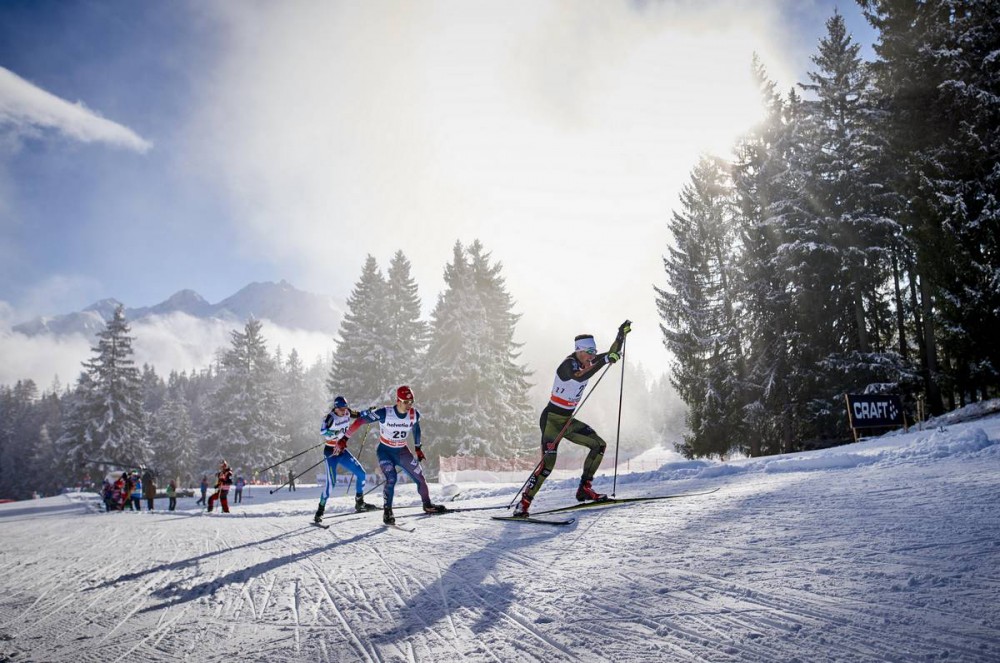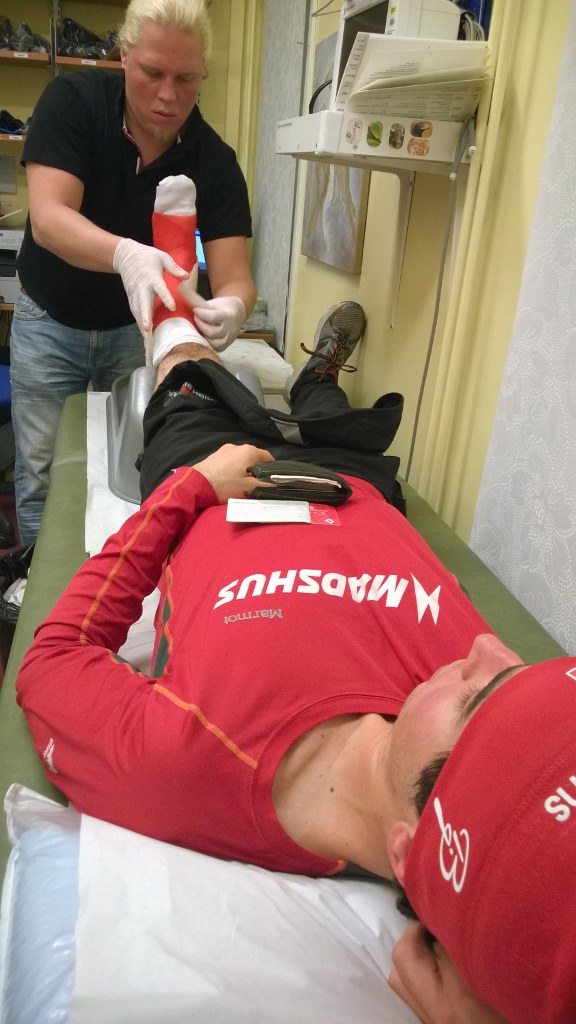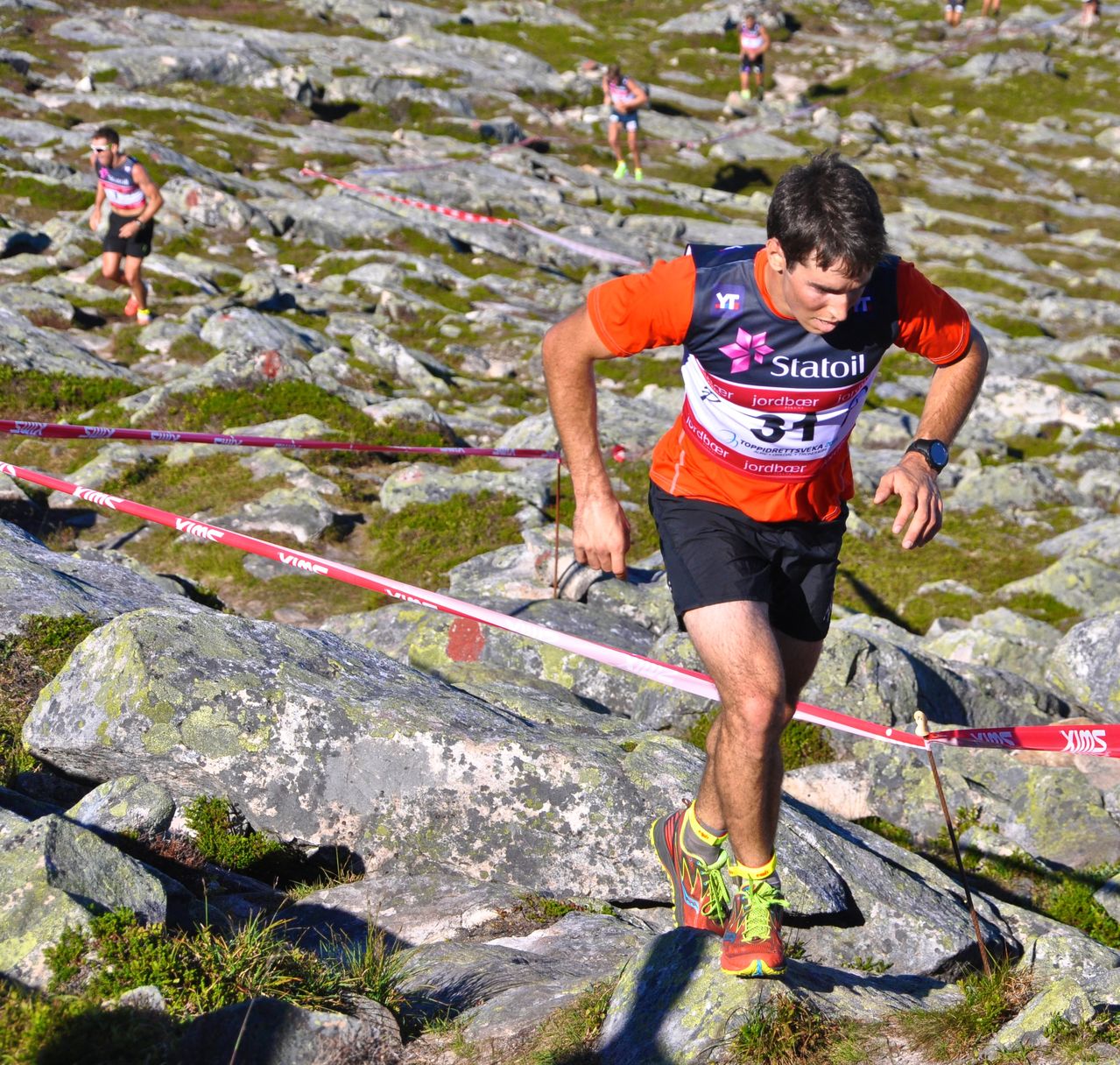
At 27, Noah Hoffman has had a singular goal — to be one of the best cross-country skiers in the world. From his hometown of Aspen, Colo., to the Sun Valley Ski Education Foundation in 2007, to the U.S. Ski Team (USST) in 2008, Hoffman evolved into the country’s top distance skier.
Internationally, Hoffman (who switched clubs in 2009 to join Ski & Snowboard Club Vail) raised expectations after placing second in the 15-kilometer classic at the 2012 U23 World Championships in Erzurum, Turkey. But even earlier on, Hoffman, was tested in Europe on the World Cup circuit. In 2010, he raced seven individual World Cups, posting a best result of 31st in Gällivare, Sweden.
Over the years, Hoffman has illustrated much promise and on several occasions delivered. In the second World Cup distance race of the 2013/2014 season, he skied the fastest time of day in the 15 k freestyle pursuit in Kuusamo, Finland. A few weeks later in the Tour de Ski 35 k freestyle pursuit from Cortina to Toblach, Italy, Hoffman again placed first for cumulative time.

The following season, Hoffman was seriously injured during his first World Cup race in Kuusamo. His lower leg break was significant, yet Hoffman returned for the 2015 World Championships the following February. Nonetheless, it was a season virtually lost.
Two years later, Hoffman, a member of the USST for the last eight seasons, was not renominated to the national team this spring. For the foreseeable future, he’ll be based in Hanover, N.H., where he’ll focus on training for the 2017/2018 World Cup season while working with his coach Zach Caldwell. According to Hoffman, he has been promised Period 1 start rights.
Despite the shift, his singular focus remains.
“My goal continues to be to execute good races, representative races, and to me, I believe that means that on the courses and days that suit me, of which there are numerous but not all on the World Cup, that I can be easily in the top 1o,” Hoffman said Monday on the phone from Putney, Vt. “And on a good day, I can be on a podium or be winning those races. And I’ve done that. I’ve done that twice before and that’s the level I want to be at.”
In a well-documented change, Hoffman embarked on a training experiment last year. Essentially, he blogged in June 2016 that his training load would increase from 678 training hours to a stated goal of 1,000 hours. (FasterSkier ran a story Hoffman’s plans a year ago.)
Athletes like Hoffman are under the microscope of a fastidious ski community, where time back and place often define how fans of the sport perceive its elite athletes. But the human component, the parts that make Hoffman a whole person, those are not so tidy and quantifiable like training hours and race results. At his core, Hoffman is a risk taker. He’s unafraid of failure and the potential Monday-morning-quarterback scrutiny.
Around this time last year, he decided to take a calculated gamble. He understood the downside. He understood the upside. He laid everything out there.
Middling on the World Cup and skiing stale, as he explained he’s felt for some time on the World Cup, were not why he pursued the sport at its highest level. After the big training load year, his intended outcome — consistent top World Cup finishes — never materilaized.
Seeing It Through
“I did the Peak Series which was a three-race series,” Hoffman said when asked to describe how his fitness sensations morphed as he accumulated the training load. “I did two of them in Park City last year.”
The races were purely mountain running, pretty much a test of aerobic fitness as courses ascend and descend some of the Wasatch’s local ski areas. The two events Hoffman contested were the Deer Valley and Snowbird races.
“Especially the Snowbird one, I was in really good shape for those,” he recalled. “I think I was putting down an effort that was World Cup podium. And I was like, that’s the type of representative effort of really good fitness that I am always looking for.”

Hoffman won the Deer Valley race. Ditto in Snowbird. Both races were during the summer.
Then Hoffman headed off to a USST camp in New Zealand in September. Hoffman said in 21 days, which included travel to and from New Zealand, he trained 77.5 hours — a lot by anybody’s standards.
Post-New Zealand, he said his sharpness when it came to high-end efforts dulled. Four days after returning from that training camp he competed at the Xterra Trail Running National Championship, a 21 k (13-mile) half marathon.
“And no surprise, jet lagged and tired, I just got completely blown out of the water,” Hoffman said. “But it wasn’t just bad, and we still wrote it off as just being jet lagged and tired. It was, like, catastrophically bad. It was on the order of being ten minutes back from a runner I had just crushed a month earlier.”
Hoffman placed seventh in that race. In Deer Valley, he finished more than 10 minutes ahead of the man who placed sixth at the Xterra Championship. Another runner Hoffman had beaten by 3 1/2 minutes in Deer Valley beat Hoffman by nearly the same margin at Xterra.
Hoffman entered another half marathon about two weeks later. He won that race, too, he said, by two to three minutes. All was fine until Hoffman noted his finish time was relatively slow compared to his other half-marathon times.
“So maybe it was just a slow day for some reason, and I kind of wrote that one off, too,” he said.
Then during a benchmark time-trial session with the Canadian national team and its top skier Alex Harvey at Soldier Hollow (SoHo) near Midway, Utah, Hoffman was disappointed.
“Alex caught me from 30 seconds down pretty early,” he recalled. “I had the same time trial with those guys the year before, and he had caught me from 15 seconds down, but not until right near the end of the race. And this year he caught me from 30 down pretty early on. And it was just another one of those just-not-quite-there. But again, I just wrote it off to training load.”
There was another disappointment — a muted time-trial performance with the USST in SoHo as well.
Heading into the season, Hoffman could recall the moments when the positive indicators should have fired but hadn’t. As the race season transpired, there remained the hope and faith that his body would absorb the training.

“There was some OK skiing, but it just wasn’t great and it wasn’t feeling great,” Hoffman said of his race season. “It wasn’t clicking. I was just kind of there until I got really sick and then I wasn’t even close to being there. There was nothing good. Nothing. It wasn’t coming around. It was like in race results and in tests, and I could date it to New Zealand camp.”
What was not widely known was that Hoffman came down with an pneumonia following the pre-Olympic World Cups in PyeongChang, South Korea. Those races concluded on Feb. 5 and were followed by races in Otepää, Estonia, the weekend of Feb. 18-19, and then, wham, 2017 World Championships, which started Feb. 22 in Lahti, Finland.
His illness thoroughly wiped him out. The first race he contested at worlds was the 30 k skiathlon on Feb. 25, and he placed 57th of 58 finishers. Walking through the mixed zone post-race was a visibly wrecked looking skier— bloodshot eyes, sunken cheeks, a slow gait.
“I never lost hope until Oslo,” Hoffman said about finishing out the season after World Championships. The Oslo 50 k classic mass start at Holmenkollen was a short week after the 50 k freestyle mass start at worlds.
“Maybe it was really the 50 at worlds,” he continued. “Until the 50 at worlds, I never really lost belief that I wouldn’t turn the corner on it. I believed I could come around and have some really good results. I guess I didn’t have thoughts about calling the season until probably 10 k into the 50 at worlds … It was a long 40 k.”
He placed 50th out of 62 finishers in that final race of World Championships. At Holmenkollen, he finished 37th out of 47.
Hoffman remains a to-the-core Westerner. His move to the East Coast is a game changer. First and foremost, it’s lower in altitude than his longtime training base in Park City (which is 7,000 feet above sea level). Hanover is comparatively an oxygen bath at an altitude of 530 feet.
But as Hoffman’s ski career evolves, so does his perception of where he can be both happy and build World Cup level fitness.
“It had nothing to do with the altitude,” Hoffman said when asked why he hadn’t moved to a lower-altitude training base in the past. “It was just about not wanting to leave the Mountain West. I love the desert, I want it to be a part of my entire life … and being home, I mean, Park City was just as much home as Sun Valley or Aspen. I don’t have one specific place that is home, but I do consider the Mountain West and the Colorado Plateau of the United States to be home.
“I will say that over the last year, my justification for wanting to stay home, if you use that previous definition of home, was that I believed that being happy was important to skiing fast. And looking back on the last year I will say that I have always paid lip service to that fact. But now I actually believe it: that actually being happy is important to skiing fast. And so that is almost counterintuitive, that now I am moving away from what I believe makes me happy. But I no longer believe that I need to be in the West to be happy.”
Hoffman remains open to change, open about his training audacity and open to finding the silver lining in his non-USST status. After such a grind of a season, Hoffman could have folded. He could have traded his ski quiver for a stack of Ed Abbey books, a climbing rope, a mountain bike, and lighted out for the desert.
He’ll be back for at least one more go. He more or less decided that before knowing if he had been renamed to the national team or not.
“Zach and I did talk before that point about wanting to not let the team decision dictate whether I was going to ski race again or not,” Hoffman said. “Basically not wanting the coaches to have the control about ending my career, because that’s my decision to make. Zach really wanted me to actually make a decision about whether I was going to ski or not again before I found out about the team decision, and I certainly did a lot of thinking about it. I never made a declaration before I got [USST Head Coach Chris] Grover’s call that I wanted to ski again, but … I was talking as if I was going to ski again. I never felt totally done with the sport.
“I want to be one of the best skiers in the world and I believe that I can,” he added. “My goal has never been to qualify for the Olympics. I want to be skiing best in the world, and I believe I can do that all season long and I want to prove it.”
Jason Albert
Jason lives in Bend, Ore., and can often be seen chasing his two boys around town. He’s a self-proclaimed audio geek. That all started back in the early 1990s when he convinced a naive public radio editor he should report a story from Alaska’s, Ruth Gorge. Now, Jason’s common companion is his field-recording gear.



